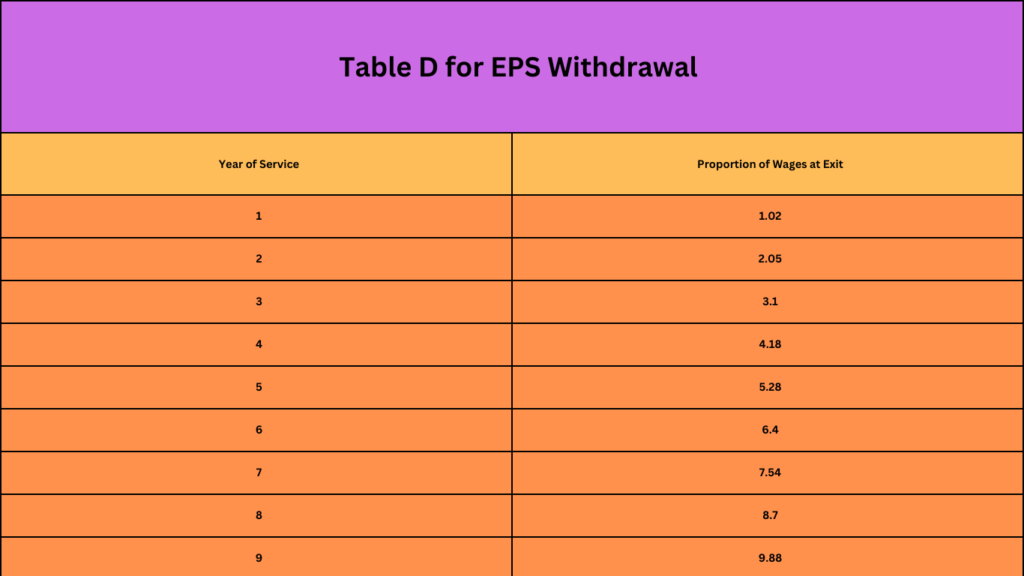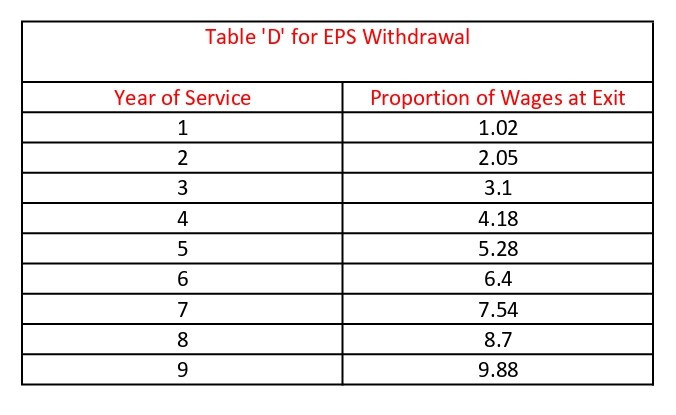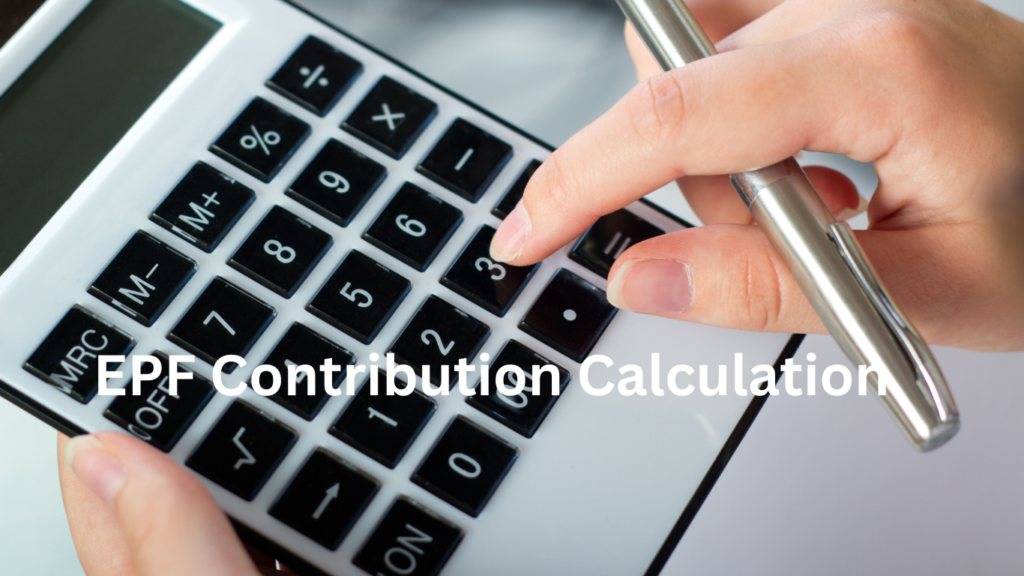For many EPF members, calculate pension amount in EPF using Table D can be confusing. What is Table D in pension calculation? Table D is a crucial tool used to determine the pension amount based on the number of service years and average salary. If you’ve recently withdrawn your EPF and noticed that the pension amount seems lower than expected, understanding how to calculate the EPS withdrawal amount can help clarify the process. This guide will walk you through the steps, highlighting key factors that impact your pension and offering tips to maximize your retirement benefits.

Understand the Full and Final Settlement for EPF
When employees leave a company and apply for Form 19 (for PF withdrawal) and Form 10C (for EPS withdrawal), they often find that their EPF withdrawal is complete, but the pension amount may be lower than expected. This discrepancy is due to the way EPFO calculates pension amounts. The pension is not based on the total amount in your PF account but on specific calculations defined in Table D.
Read this full and final settlement epf process
What is Table D in Pension Calculation
EPFO Table D is a crucial tool in pension calculation, and it outlines the factors based on years of service and the final wage amount. Here’s how it works:
- Years of Service: Only complete years are counted. For instance, if an employee has worked for 4 years and 4 months, EPFO considers only 4 years in their calculation. If they worked for 4 years and 7 months, it would round up to 5 years.
- Wages at the Time of Exit: The final wages (specifically, the EPS wages) at the time of exit play a key role. Table D provides specific multipliers based on the years of service. For example, if you worked for four years, the multiplier is 3.99; if you worked for five years, it’s 5.02.
How to Calculate EPS Withdrawal Value Using Table ‘D’ Under EPF
The Employee Pension Scheme (EPS), which is part of the EPF, allows employees to withdraw a portion of their pension based on their years of service if they choose to exit before reaching the pensionable age of 58. Table ‘D’ provides a method to calculate the EPS withdrawal amount depending on the total years of service.
Understanding Table ‘D’
Table ‘D’ is used to determine the proportion of wages that an employee is eligible to receive as EPS withdrawal based on the years of service completed. Below is the breakdown as per the table:
visit site epfo for detail info

Steps to Calculate EPS Withdrawal Amount using Table D
1. Determine Last Monthly Wages:
– Find the last monthly wages or salary (basic + dearness allowance) on which the EPS contribution was made.
– For example, if your last monthly wage was Rs. 15,000, you would use this as the base amount.
2. Identify Years of Service:
– Identify the total number of completed years of service before exit from the EPS scheme.
– If you worked for 6 years, refer to the “6 years” row in Table D.
3. Find the Proportion of Wages:
– According to Table ‘D’, the proportion for 6 years of service is 6.4. This proportion represents the multiple of wages an employee will receive for EPS withdrawal.
4. Calculate EPS Withdrawal Amount:
– Multiply your last monthly wages by the proportion from Table ‘D’.
– For instance, if your last wage was Rs. 15,000 and your completed service years are 6, the calculation would be:
{EPS Withdrawal Amount} = {Last Monthly Wages} * {Proportion}
= 15,000 \times 6.4 = 96,000
Example Calculation Scenarios
Let’s walk through a couple of examples to make it clearer:
Example 1:
Last Monthly Wage: Rs. 12,000
Years of Service: 3
Proportion for 3 Years: 3.1 (as per Table D )
EPS Withdrawal Amount: 12,000 * 3.1 = 37,200
Example 2:
Last Monthly Wage: Rs. 18,000
Years of Service: 5
Proportion for 5 Years: 5.28 (asper Table D )
EPS Withdrawal Amount: 18,000 * 5.28 = 95,040
Read This Also: know everything about pension fund
Important Points to Note
Eligibility: Only employees who exit before the age of 58 can withdraw their EPS amount. After this, they are eligible for a monthly pension.
Rounding of Service Years: If the service period includes more than 6 months but less than a full year, it is rounded up to the next year. If it’s less than 6 months, it is rounded down.
Partial Withdrawal: EPS withdrawal is only a portion of the entire EPF amount. The remaining EPF balance will be in the PF account, which is based on contributions by the employee and employer.
By following these steps, employees can calculate their eligible EPS withdrawal amount using Table ‘D’ easily. This information can be beneficial for those who need funds before retirement age and are considering exiting the EPS scheme.
Special Considerations
1. Service Periods of Less Than 6 Months: EPFO does not count service periods shorter than six months towards pension eligibility. For example, if you have worked 4 years and 4 months, only four full years will count. However, if you reach 4 years and 7 months, it rounds up to 5 years.
2. Service Exceeding 9 Years and 6 Months: If an employee’s service duration exceeds 9 years and 6 months, they become eligible for the EPS 95 pension scheme, meaning they can receive a monthly pension upon turning 58 years old.
3. Impact of Multiple Employment Periods: If you have multiple PF accounts from different jobs, make sure to transfer all your past PF balances to your current PF account before applying for a final settlement. This ensures that all contributions are counted in the final calculation.
Conclusion:
Conclusion
Calculating your pension amount in EPF using Table D is essential for those planning early withdrawals or concerned about their pension. By following this guide, you can determine your EPS withdrawal amount based on your years of service and final wages. Discrepancies may occur due to EPFO’s pension calculations, so it’s vital to ensure accurate records of your service years and wages. For those leaving before age 58, understanding EPS calculations aids in making informed retirement decisions. Always consider service year rules and consolidate your PF accounts to maximize benefits.
FAQs on Calculating Pension Amount in EPF Using Table D
1. What is Table D in pension calculation?
Table D is a tool used by EPFO to calculate the Employee Pension Scheme (EPS) withdrawal amount based on the number of years of service and final wages.
2. How do I calculate my EPS withdrawal amount?
To calculate your EPS withdrawal amount, multiply your last monthly wages by the corresponding factor (proportion) from Table D based on your years of service.
3. What factors are considered in Table D for pension calculation?
Table D considers two main factors: the total number of complete years of service and the final monthly wages (basic salary + dearness allowance) at the time of exit.
4. How are incomplete years of service calculated in Table D?
Service periods less than 6 months are not considered for pension eligibility. Periods exceeding 6 months but less than a year are rounded up to the next year, and periods less than 6 months are rounded down.
5. Can I withdraw my EPS before retirement age?
Yes, if you exit the scheme before the age of 58, you can withdraw a portion of your EPS based on your service years and final wages using Table D.
6. Is the EPS withdrawal amount the same as the pension amount?
No, the EPS withdrawal amount is a one-time payment made when you exit the scheme, while the pension is a monthly benefit paid once you reach the pensionable age of 58.
7. How does my final wage affect the EPS withdrawal amount?
Your final wages directly impact the EPS calculation. A higher salary leads to a higher EPS withdrawal amount, as the proportion in Table D is multiplied by your last wage.
8. What if I have multiple PF accounts?
Make sure to transfer all your past PF balances to your current PF account before applying for the final settlement to ensure that all contributions are considered in the calculation.
9. What happens if I have worked for more than 9 years and 6 months?
If your service exceeds 9 years and 6 months, you become eligible for the EPS 95 pension scheme, which allows you to receive a monthly pension once you turn 58.
10. Can I calculate my EPS withdrawal amount myself?
Yes, by using the steps outlined in this guide and referring to Table D, you can easily calculate your EPS withdrawal amount based on your final wages and service years.


